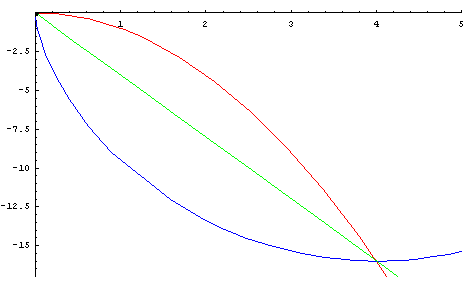최단시간강하곡선 문제(Brachistochrone problem)
개요
- 중력을 받고 있는 물체가 정지상태에서 출발하여 가장 짧은 시간내에 하강하기 위해서 따라야 하는 곡선
- 1697년에 베르누이에 의하여 답이 출판
곡선의 시작점을 \((x_0,y_0)=(0,0)\), 끝점을 \((x_1,y_1)\)라 두자.
곡선을 따라 내려올때 걸리는 시간은 다음과 같이 구할 수 있다.
\(t=\int \frac{1}{v} \, ds\)(v는 속력, ds 는 길이요소, t는 시간)
에너지 보존 법칙 \(mgy=\frac{1}{2}mv^2\) 에서\(v=\sqrt{2gy}\).
이제 곡선의 x좌표를 y의 함수로 생각하자. 곡선을 따라 내려올 때 걸리는 시간은 \[T=\int \frac{1}{v} \, ds=\frac{1}{\sqrt{2g}}\int_{0}^{y} \frac{\sqrt{1+x'(y)^2}}{\sqrt{y}} \, dy\]
문제의 정의에 따라 이 적분값을 최소가 되게 하는 곡선을 찾아야 한다.
\(F(y,x,x')=\frac{\sqrt{1+(x')^2}}{\sqrt{y}}\) 에 대하여 오일러-라그랑지 방정식 을 적용하면, \[0 =\frac{\partial F}{\partial x} - \frac{d}{dy} \frac{\partial F}{\partial x'}=-\frac{d}{dy}(\frac{x'(y)}{\sqrt{y(1+x'(y)^2)}})\]
적당한 상수 a에 대하여 \(\frac{x'(y)}{\sqrt{y(1+x'(y)^2)}}=\frac{1}{\sqrt{2a}}\)라 두자.
이를 풀면 다음의 미분방정식을 얻는다. \[\frac{dx}{dy}=\sqrt{\frac{y}{2a-y}}\]
(미분방정식의 여러 해에 대한 논의는 http://whistleralley.com/brachistochrone/brachistochrone.htm)
\(x=\int_{0}^{y}\sqrt{\frac{y}{2a-y}}dy\), \(y=2a\sin^2\frac{\theta}{2}=a(1-\cos\theta)\)로 치환하면, \(x=a(\theta-\sin\theta)\)를 얻는다.
여기서 상수 a는 주어진 점 \((x_1,y_1)\)를 지날 수 있는 값으로 결정된다.
따라서 사이클로이드를 얻었다.■
재미있는 사실
- http://en.wikipedia.org/wiki/Half-pipe ?
- Half-Pipe Skateboarding ?
수학용어번역
- Brachistochrone curve
- brachistos - the shortest, chronos - time
- 최단시간강하 곡선, 최속강하선, 최단강하선
관련된 항목들
매스매티카 파일 및 계산 리소스
사전 형태의 자료
- http://ko.wikipedia.org/wiki/
- http://en.wikipedia.org/wiki/Brachistochrone_problem
- http://curvebank.calstatela.edu/brach/brach.htm
- http://mathworld.wolfram.com/BrachistochroneProblem.html
관련논문
- The Brachistochrone Problem
- Nils P. Johnson, The College Mathematics Journal, Vol. 35, No. 3 (May, 2004), pp. 192-197
- Exploring the Brachistochrone Problem
- LaDawn Haws, Terry Kiser, The American Mathematical Monthly, Vol. 102, No. 4 (Apr., 1995), pp. 328-336
관련도서
링크
노트
말뭉치
- More specifically, the brachistochrone can use up to a complete rotation of the cycloid (at the limit when A and B are at the same level), but always starts at a cusp.[1]
- According to Newtonian scholar Tom Whiteside, in an attempt to outdo his brother, Jakob Bernoulli created a harder version of the brachistochrone problem.[1]
- Johann Bernoulli's direct method is historically important as it was the first proof that the brachistochrone is the cycloid.[1]
- In this blog post, we demonstrate how to use built-in mathematical expressions and the Optimization Module in COMSOL Multiphysics to solve for the brachistochrone curve.[2]
- The brachistochrone curve is an idealized curve that provides the fastest descent possible.[2]
- Next, we use an interpolation function to approximate the brachistochrone curve.[2]
- The brachistochrone curve is a classic physics problem, that derives the fastest path between two points A and B which are at different elevations.[3]
- There is no better way to learn than through STEM, so follow on to make your very own working brachistochrone model.[3]
- Before I end I must voice once more the admiration I feel for the unexpected identity of Huygens' tautochrone and my brachistochrone.[4]
- This article presents the problem of quickest descent, or the Brachistochrone curve, that may be solved by the calculus of variations and the Euler-Lagrange equation.[5]
- The rst step in the solution of the Euler-Lagrange equation for the brachistochrone problem: is to reduce it to a rst-order equation.[6]
- the red cycloid beats the other two It can also be asked what the brachistochrone curve among the curves joining two points and having a given shape would be.[7]
- For example, for two points at the same altitude and V-shaped curves, the brachistochrone curve is the one for which the angle of the V is a right angle, as is shown in the animation opposite.[7]
- The problem of the brachistochrone with given length is studied on this page.[7]
- One can also try to find the brachistochrone "with friction".[7]
- The brachistochrone problem was one of the earliest problems posed in the calculus of variations.[8]
- Brachistochrone, the planar curve on which a body subjected only to the force of gravity will slide (without friction) between two points in the least possible time.[9]
- The name brachistochrone comes from two Greek words, brachistos meaning shortest, and chronos meaning time.[10]
- The brachistochrone curve can be generated by tracking a point on the rim of a wheel as it rolls on the ground.[10]
- This mathematical challenge is known as the problem of the brachistochrone.[11]
- Figure 3: Newton’s handwritten solution to the brachistochrone problem (source).[11]
- The classical problem in calculus of variation is the so called brachistochrone problem 1 posed (and solved) by Bernoulli in 1696.[12]
- Abstract: This article presents the problem of quickest descent, or the Brachistochrone curve, that may be solved by the calculus of variations and the Euler-Lagrange equation.[13]
- Historically and pedagogically, the prototype problem introducing the cal- culus of variations is the brachistochrone, from the Greek for shortest time.[14]
소스
- ↑ 1.0 1.1 1.2 Brachistochrone curve
- ↑ 2.0 2.1 2.2 How to Solve for the Brachistochrone Curve Between Points
- ↑ 3.0 3.1 The Brachistochrone Curve
- ↑ Brachistochrone problem
- ↑ Osaka keidai ronshu, vol. 61 no. 6 march 2011
- ↑ The brachistochrone problem.
- ↑ 7.0 7.1 7.2 7.3 Brachistochrone
- ↑ Brachistochrone Problem -- from Wolfram MathWorld
- ↑ Brachistochrone | physics
- ↑ 10.0 10.1 myPhysicsLab Brachistochrone
- ↑ 11.0 11.1 The Famous Problem of the Brachistochrone
- ↑ Basics of calculus of variations
- ↑ International journal of pure and applied mathematics
- ↑ Physics 129a
